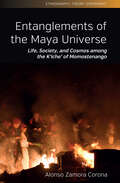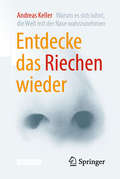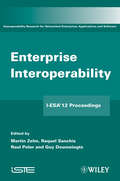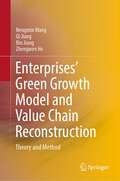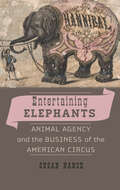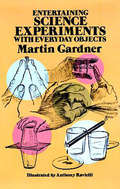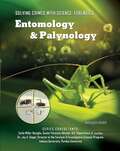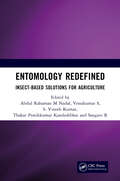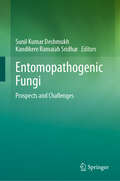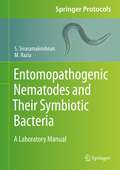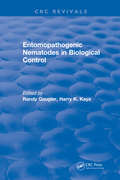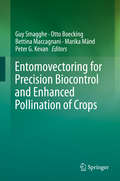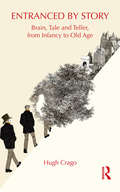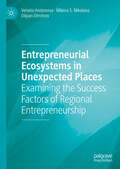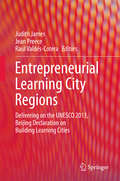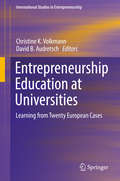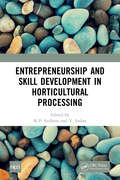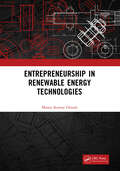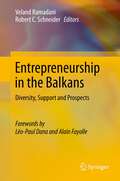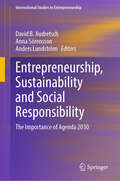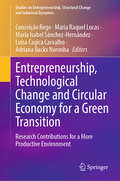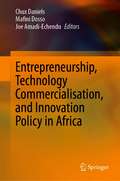- Table View
- List View
Entanglement: The Greatest Mystery in Physics
by Amir D. AczelWhy packages separated by thousands of miles change together.
Entanglements of the Maya Universe: Life, Society, and Cosmos among the K'iche' of Momostenango (Ethnography, Theory, Experiment)
by Alonso Rodrigo Zamora CoronaCosmology or cosmological ideas are often sought to solve problems in our daily lives. This book aims to rethink the topic of cosmology in anthropology through an ethnographic description of the many entanglements of cosmological ideas and the personal and political lives of individuals within the K’ich’e Maya community of Momostenango, Guatemala. It addresses the question of why they turn to cosmology in an everyday context and how ‘efficient’ it is. It also shows the way Indigenous cosmological ideas are echoed by contemporary philosophical and scientific conceptions.
Entdecke das Riechen wieder: Warum es sich lohnt, die Welt mit der Nase wahrzunehmen
by Andreas KellerWarum es sich lohnt, die Welt mit der Nase wahrzunehmenEntdecke das Riechen wieder riecht wie alle anderen Bücher, aber nachdem Sie es gelesen haben, werden Bücher und vieles andere für Sie nicht mehr so riechen wie zuvor. Ob es bei Menschen Pheromone gibt, warum es so schwierig ist, über Gerüche zu reden, welches Tier den besten Riecher hat und warum manche Menschen den Geruch von Spargel-Urin nicht riechen können - das sind nur einige der Fragen, die der Geruchsforscher Andreas Keller in diesem Buch beantwortet. Menschen besitzen eine gute Nase, haben aber im Laufe der Evolution mehr und mehr verlernt, sie zu benutzen. Dieses Buch wird Sie überzeugen, dass Riechen nicht so mysteriös ist, wie oft angenommen, und dass es sich lohnt, die Welt wieder (auch) mit der Nase wahrzunehmen. In einem Zeitalter, das von digitalisierten Erfahrungen geprägt ist, die beliebig kopiert und für die Ewigkeit gespeichert werden können, bedeutet die flüchtige Realität eines Geruches mehr als je zuvor.
Entering Research: Workshops For Students Beginning Research In Science
by Amber Smith Janet Branchaw Amanda ButzFor students whose experience with science has been primarily in the classroom, it can be difficult to identify and contact potential mentors, and to navigate the transition to a one-on-one, mentor-student relationship. This is especially true for those who are new to research, or who belong to groups that are underrepresented in research. The Entering Research curriculum offers a mechanism to structure the independent research experience, and help students overcome these challenges.
Enterprise Interoperability: I-ESA'12 Proceedings (Lecture Notes In Business Information Processing Ser. #122)
by Guy Doumeingts Raquel Sanchis Raul Poler Martin ZelmIn a fast changing world governed by innovative Enterprise Services and the Future Internet, the issue of Enterprise Interoperability is no longer limited to the interoperation of systems within a single company, but has become a much greater multi-view issue of interoperability throughout a Network of Enterprises. This book contains the proceedings of 13 workshops presented as short papers and discussions held at each workshop. The workshops were co-located with the I-ESA’12 Conference organized by the Polytechnic University of Valencia, Spain. Complementary to the conference program, the workshops aimed at exploiting new issues, challenges and solutions for Enterprise Interoperability. The scope of the workshops spanned a wide range of interoperability issues in Service Science and Innovation, Model Driven Interoperability, Service Oriented Architectures, Factories of the Future, Enterprise Networks and Management, SME Aspects and Standards.
Enterprises’ Green Growth Model and Value Chain Reconstruction: Theory and Method
by Bin Jiang Qi Jiang Nengmin Wang Zhengwen HeThe goal of this book is to improve the ability of enterprises to implement the green growth model and value chain reconstruction. China’s environmental development strategies, such as carbon peak emission and carbon neutrality, have created new challenges and requirements for enterprises to “go green.” In addition, anti-globalization and the complex dynamic uncertainty caused by COVID-19 have changed the operational environment that enterprises face. The application of new technologies, including the new generation of information technologies and the whole process management technology, provides solutions for the implementation of enterprises’ green growth model and value chain reconstruction. Based on China’s enterprise management cases, this book reveals the connotative features of enterprises’ green growth model and their evolutionary regularities, the overall framework and decision optimization of value chain reconstruction under the green growth model, and the approach to implementing the green growth model and value chain reconstruction. The theoretical framework of the green growth model and value chain reconstruction established in this book has enriched and developed the research results in this field. Cases of enterprises implementing the green growth model can provide references for the green transformation of enterprises and help enterprises appreciate the synergy between sustainability and growth. This book can also serve as a research reference for scholars engaged in the field of sustainable operations, as well as decision-makers and managers of relevant government departments.
Entertaining Elephants: Animal Agency and the Business of the American Circus (Animals, History, Culture)
by Susan NanceHow the lives and labors of nineteenth-century circus elephants shaped the entertainment industry.Consider the career of an enduring if controversial icon of American entertainment: the genial circus elephant. In Entertaining Elephants Susan Nance examines elephant behavior—drawing on the scientific literature of animal cognition, learning, and communications—to offer a study of elephants as actors (rather than objects) in American circus entertainment between 1800 and 1940. By developing a deeper understanding of animal behavior, Nance asserts, we can more fully explain the common history of all species.Entertaining Elephants is the first account that uses research on animal welfare, health, and cognition to interpret the historical record, examining how both circus people and elephants struggled behind the scenes to meet the profit necessities of the entertainment business. The book does not claim that elephants understood, endorsed, or resisted the world of show business as a human cultural or business practice, but it does speak of elephants rejecting the conditions of their experience. They lived in a kind of parallel reality in the circus, one that was defined by their interactions with people, other elephants, horses, bull hooks, hay, and the weather. Nance’s study informs and complicates contemporary debates over human interactions with animals in entertainment and beyond, questioning the idea of human control over animals and people's claims to speak for them. As sentient beings, these elephants exercised agency, but they had no way of understanding the human cultures that created their captivity, and they obviously had no claim on (human) social and political power. They often lived lives of apparent desperation.
Entertaining Science Experiments with Everyday Objects
by Martin GardnerTo Martin Gardner, seeing is not just believing -- it is understanding. This fundamental rule has made him one of the most successful teachers and popularizers of science in America. With the simple instructions in this book and a few commonly available household objects, you or your child can easily learn even the most difficult scientific principles by directly experiencing how they work.Gardner shows you how to re-create classic experiments with easily obtainable objects. Using just a flashlight, a pocket mirror, and a bowl of water, you can demonstrate the color composition of white light just as Newton did 300 years ago. With cardboard, colored paper, and wax paper you can perform "Meyer's experiment" with complementary colors. You need only a playing card, a spool, and a thumbtack to demonstrate Bernoulli's principle of aerodynamics. A soda bottle filled with water, a few paper matches, and a toy balloon elucidate Pascal's law governing pressure in liquids. And two drinking glasses, some matches, and a piece of wet blotting paper re-create a famous experiment, first performed in 1650 in Magdeburg, Germany, that dramatically reveals the force of ordinary atmospheric pressure.In language simple enough to be easily understood by an 11-year-old, yet technically accurate and informative enough to benefit adults, and aided by Anthony Ravielli's clear illustrations, Gardner presents a splendid practical course in basic science and mathematics. While your child perplexes and delights his or her friends with a series of 100 amusing tricks and experiments, he or she is learning the principles of astronomy, chemistry, physiology, psychology, general mathematics, topology, probability, geometry, numbers, optics (light), gravity, static electricity, mechanics, air hydraulics, thermodynamics (heat), acoustics (sound), and inertia. This is a perfect refresher course for adults as well as an ideal introduction to science for youngsters."The experiments ... are all clearly explained and unusually well illustrated." -- Booklist.
Entomology & Palynology: Evidence From The Natural World (Solving Crimes With Science: Forensics #12)
by Maryalice WalkerWho committed the crime? When? Even the smallest of witnesses can tell scientists stories that will make or break a criminal case. Insects and pollen grains help forensic scientists bring criminals to justice. A suspect escapes a crime scene, leaving not a trace of evidence behind--except for the hind leg of a grasshopper, which helps convict him of murder. A thief runs through a cornfield, relieved that no one saw him commit the crime--unaware of the tiny grains of pollen stuck to his shirt. Plants and insects hold clues to guilt or innocence. Evidence from nature is all around us, silently and swiftly leaving fingerprints, unnoticed by even the most cunning of criminals.
Entomology Redefined: Insect-Based Solutions For Agriculture
by Abdul Rahaman M Nadaf S Venukumar S. Vinoth Kumar Thakar Pratikkumar Kamleshbhai R SangaviAlthough their significance often goes unnoticed in our day-to-day lives, insects are diverse creatures that play an indispensable role in our ecosystems.This book presents an in-depth discussion about the field of entomology and discusses the anatomy and physiology of insects, their unique body structures, and how they contribute to their diverse ways of life. It also details the mechanisms behind their behaviors – from intricate mating rituals to elaborate communication methods, and explores the vital roles insects play in pollination, nutrient cycling, and maintaining the delicate balance of ecosystems.The subject matter of this book also includes stories of insect discovery, examples of research, and insights into the ongoing efforts to conserve insect diversity in the face of environmental challenges.Print edition not for sale in South Asia (India, Sri Lanka, Nepal, Bangladesh, Pakistan or Bhutan)
Entomopathogenic Fungi: Prospects and Challenges
by Kandikere Ramaiah Sridhar Sunil Kumar DeshmukhThis book brings together the molecular aspects of the pathogenesis of entomopathogenic fungi, various aspects of mycoinsecticide development, and regulatory aspects to highlight the immense contribution of the agricultural sector. The chapters address aspects of entomopathogenic fungi, including host-pathogen interactions (susceptibility and resistance), fungus-insect and fungus-fungus dual interactions, phylogeny and taxonomy, biochemistry, and molecular basis of enteropathogenesis, market potential of entomopathogens, regulatory aspects, bioprospecting of fungi, fungi as crop bodyguards and in disease suppression, and consortia for the control of insect pests and pathogens in single crop systems. Written by experts in academia and industry from Algeria, Brazil, Hungary, India, Italy, Malaysia, Oman, Pakistan, and the United States, the book overviews entomopathogenic fungi used as biological control agents against insect pests and other arthropods, their mode of action, pathogenesis, bioactive metabolites, mycotoxins involved, their mass production, limitations, and agricultural- and environment-related issues. It also includes developing various biopesticide products, with special references to formulations and prospects. In agriculture, crop protection and production depend on insect pests controlled by entomopathogenic fungi. Understanding the pathogenicity, mechanism of action, formulations, and applications of a wide array of entomopathogenic fungi as biopesticides is a valid eco-friendly approach. The book provides advances in pathogenicity, biochemistry, virulence, and interaction that facilitate the application of Beauveria, Metarhizium, and other entomopathogens as potential biopesticides against major insect pests. Developments in bioactive compounds, secondary metabolites, enzymes, and toxins of entomopathogenic fungi have facilitated precise applications and management to target insect pests. Further advances in molecular aspects, the formulation of nanobiopesticides, and biofabricated technology paved the way for insect pest control. This book will be a helpful resource for students, teachers, researchers, scientists, and professionals in the industry working on biological sciences, applied entomology, mycology, zoology, forestry, biochemistry, molecular biology, and nanotechnology.
Entomopathogenic Nematodes and Their Symbiotic Bacteria: A Laboratory Manual (Springer Protocols Handbooks)
by S. Sivaramakrishnan M. RaziaThis book provides basic information and different protocols associated with the Entomopathogenic nematodes (EPNs) and their symbiotic bacteria. Entomopathogenic nematodes (EPNs) of the genera Steinernema and Heterorhabditis and their associated bacterial symbionts Xenorhabdus and Photorhabdus aid nematode infective juveniles (IJs) in infecting and killing their insect hosts, creating a unique tripartite complex of host-vector-symbiont interactions. Due to this insect killing capability, EPNs are used as biological control agents of economically important insect pests. They are also a model system to study host-parasite interactions.It provides a systematic approach to various nematode procedures including pathogenicity, reproduction, foraging behaviour. It gives a brief outline on historical aspects, nematode-bacterium complex, biology and chemical ecology of EPNs. It concisely describes host insect rearing, nematode sampling and storage, isolation techniques, counting, handling and staining of nematodes, characterization including morphological, molecular and ecological studies, mass production, virulence bioassay, field application and efficacy. The book also includes methods and techniques for their associated symbiotic bacteria.This book serves as a laboratory manual and assists the readers to undertake advanced research in different aspects related to nematodes. It is useful for researchers in the fields of nematology, microbiology, bacteriology and entomology.
Entomopathogenic Nematodes in Biological Control
by Randy GauglerThe editors of this book, who are world renown for their creativity with entomopathogenic nematodes, have assembled the foremost authorities from four continents to contribute on basic and applied concepts. The authors have taken advantage of this opportunity to express their views to a wide scientific audience. They have combined their international experience so that the latest developments in this fascinating and rapidly expanding field are present in comprehensive manner with diverse topics ranging from biological control theory to organismal and molecular biology.
Entomovectoring for Precision Biocontrol and Enhanced Pollination of Crops
by Guy Smagghe Otto Boecking Bettina Maccagnani Marika Mänd Peter G. KevanThis book focuses on entomovectoring, also known as apivectoring, the method used for managing pollinators to increase crop yields and employ strategies of biocontrol in greenhouses and open fields. It is written by experts working in academia and industry from the different continents of the world. Over the past 25 years Research and Development has successfully investigated the potential of pollinators to perform two tasks: dispersal of biological control agents (BCOs) and their pollination service. This book provides a basic overview of the current literature on the different aspects and factors of this novel technology. It explains and presents practical cases of enhancing pollination coupled with the suppression of plant pathogens and pests under various agricultural production practices from greenhouse to open field conditions and crops ranging from orchard fruits, to small and tender berries, vegetables and oil seeds
Entranced by Story: Brain, Tale and Teller, from Infancy to Old Age (Children's Literature and Culture)
by Hugh CragoWe live in a world of stories; yet few of us pause to ask what stories actually are, why we consume them so avidly, and what they do for story makers and their audiences. This book focuses on the experiences that good stories generate: feelings of purposeful involvement, elevation, temporary loss of self, vicarious emotion, and relief of tension. The author examines what drives writers to create stories and why readers fall under their spell; why some children grow up to be writers; and how the capacity for creating and comprehending stories develops from infancy right through into old age. Entranced by Story applies recent research on brain function to literary examples ranging from the Iliad and Wuthering Heights to Harold and the Purple Crayon, providing a groundbreaking exploration of the biological and neurological basis of the literary experience. Blending research, theory, and biographical anecdote, the author shows how it is the unique structure of the human brain, with its layering of sophisticated cognitive capacities upon archaic, emotion-driven functions, which best explains the mystery of story.
Entrepreneurial Ecosystems in Unexpected Places: Examining the Success Factors of Regional Entrepreneurship
by Veneta Andonova Milena S. Nikolova Dilyan DimitrovThis book sheds light on one of the biggest development issues of our time: how the rise of entrepreneurship and the associated mindset is likely to unfold in unexpected places and change socio-economic and political fortunes. Focusing on the Balkan Peninsula, the authors explore the early success of young entrepreneurial ecosystems in the region and highlight the dangers of direct comparison with more mature entrepreneurial centres. Offering fresh insights, this brand new book presents an analytical overview of the entrepreneurial domain that enabled Bulgaria to become the start-up capital of the Balkans. With empirical data gathered from over 80 interviews and case studies, the authors address the needs of decision-makers and managers in many countries which are on the path towards nurturing entrepreneurial ecosystems.
Entrepreneurial Learning City Regions: Delivering on the UNESCO 2013, Beijing Declaration on Building Learning Cities
by Judith James, Jean Preece and Raúl Valdés-CoteraThis book proposes an alternative strategy to improve and sustain prosperity, through the creation of an entrepreneurial culture in learning cities or city regions. The edited collection provides insights into how entrepreneurship, education, job creation and social inclusion can be aligned through entrepreneurial learning, in the context of territorial development. With rich and varied contributions from a wide field, including policy makers, entrepreneurs, an investment banker, leaders of universities and councils, the voluntary sector, scientists, educators and students, it reviews and assesses how learning cities and regions may become more prosperous by investing in the development of entrepreneurial skills throughout lifelong learning. Reinforced by examples on developing and retaining entrepreneurial people, this book contributes to our understanding of how entrepreneurial learning can be fostered in different city and city-region contexts. It makes an interesting contribution to the field in terms of mapping out complex issues and testing the practical validity of the concept, while also providing rich and insightful case studies centred on the Welsh experience with entrepreneurial learning city regions. The high quality international contributions demonstrate the new worldwide interest in developing an entrepreneurial culture for the benefit of a city or region, rather than an entrepreneurial mind-set for individual benefit. This fascinating subject will be of interest to many social scientists, policymakers, and practitioners. It will be found especially valuable for professionals involved in economic, inclusive and sustainable city or regional development.
Entrepreneurship Education at Universities
by David B. Audretsch Christine K. VolkmannThis volume discusses entrepreneurship education in Europe on the basis of in-depth case studies of related activities at twenty higher education institutions. Based on a model of entrepreneurship education, the analysis addresses curricular and extra-curricular teaching, as well as the institutional and stakeholder context of delivering entrepreneurship education within higher educational institutions. The book offers both insightful entrepreneurship teaching practices and a discussion of potential organizational drivers and barriers. Accordingly, it provides a valuable resource for researchers, instructors, and managers of entrepreneurship education alike.
Entrepreneurship and Skill Development in Horticultural Processing
by K.P. Sudheer, V. IndiraThe book mainly comprises of novel food processing techniques and the equipment requirement for installation. The book also provides the scope and opportunities of entrepreneurship in the major horticultural crops like banana, mango, pine-apple, and some under-utilized fruits and vegetables. The book also enlightens the readers about the marketing strategies, business plan preparation, safety and quality issues etc. It covers almost all important aspects of entrepreneurship development in food processing sector.Note: T&F does not sell or distribute the hardback in India, Pakistan, Nepal, Bhutan, Bangladesh and Sri Lanka. This title is co-published with NIPA.
Entrepreneurship in Renewable Energy Technologies
by Manoj Kumar GhosalThis book focusses on various options of taking up ventures for starting entrepreneurship in small/large scale in the field of renewable energy technologies. The book covers the fundamentals of entrepreneurship, renewable energy resources, their technologies involved and applications along with financial evaluations. The book will cater to the needs of students, researchers, various stakeholders, entrepreneurs etc. by providing valuable information on renewable energy technologies and their applications in developing entrepreneurship and establishing enterprise at individual level, specifically focusing on low carbon technology for sustenance of environment which is becoming increasingly important.
Entrepreneurship in the Balkans: Diversity, Support and Prospects
by Veland Ramadani Robert C. SchneiderThis book represents a comprehensive state-of-the-art picture of entrepreneurship and small business management issues in the Balkans region. It provides major theoretical and empirical evidence that offers a brighter view of these fields and aims to open up opportunities for greater dialogue in public policy. The readers would be able to enhance their knowledge on small businesses and innovation issues in the Balkans. An outcome of a long lasting endeavour, this book includes contributions of highly reputed authors and experts from the Balkans' countries. Features forewords by two well-known personalities of this field, Leo Paul Dana and Alain Fayolle.
Entrepreneurship, Sustainability and Social Responsibility: The Importance of Agenda 2030 (International Studies in Entrepreneurship #48)
by David B. Audretsch Anders Lundström Anna SörenssonThis edited collection unveils the pivotal role of entrepreneurship in realizing the 2030 Agenda for Sustainable Development. Global scholars converge to scrutinize entrepreneurship's centrality in the transformative framework endorsed by the United Nations. Encompassing nuanced examinations, the volume surveys evolving perspectives on Agenda 2030, appraises policy implications and scrutinizes entrepreneurship's potency as a change catalyst. Chapters deal with practical applications, assessing the Agenda's efficacy in nurturing local enterprises. Exploring the interplay between corporate social responsibility and entrepreneurship, the book analyzes the potential of tailoring Sustainable Development Goals to diverse contexts. Furthermore, the book critically analyzes implementation factors and prevailing research gaps in public sector integration. In sum, this compendium exemplifies Agenda 2030's role in driving multifaceted political and local metamorphoses across sectors and is useful for researchers and policymakers alike.
Entrepreneurship, Technological Change and Circular Economy for a Green Transition: Research Contributions for a More Productive Environment (Studies on Entrepreneurship, Structural Change and Industrial Dynamics)
by Luísa Cagica Carvalho Conceição Rego Adriana Backx Noronha Maria Raquel Lucas María Isabel Sánchez-HernándezThis book is a comprehensive and timely publication that aims to be an essential reference source, building on contemporary research in the fields of circular economy and green transition in relation to entrepreneurship and technological change. This book aims to address a range of approaches including, but not limited to, the conceptual, theoretical, and case studies related to the topics of the book. The topical focus is on how circular economy contributions, energy infrastructure, green transition, and digital transformation are contributing to attaining the Sustainable Development Goals (SDGs). The expert contributions in the book particularly help us learn more about the answers to the current challenges of the green transition as well as how the necessary technological change will impact, mainly, the enterprises and the field of agriculture production and agribusiness. The book is mainly intended to support an academic audience (academics, university teachers, researchers, and post-graduate students – both Master's and Doctorate levels). In addition, this book will be of benefit to institutional experts, developers, and researchers in the fields of Entrepreneurship and technological change in circular economy and green transition.
Entrepreneurship, Technology Commercialisation, and Innovation Policy in Africa
by Joe Amadi-Echendu Chux Daniels Mafini DossoThis book provides a comprehensive overview of role of entrepreneurship, technology commercialisation and innovation policy for the achievement of economic development and prosperity in African societies. It adopts a broad innovation systems approach. The book examines entrepreneurship, innovation, and technology commercialisation alongside context-specific factors associated with them. It also provides an interdisciplinary perspective, by discussing the above disciplines in a connected way. This book is presented in three distinct parts. It starts by discussing entrepreneurship and the state of the entrepreneurial ecosystem in Africa. It then moves on to present technology commercialisation in Africa, before finally discussing the future directions for entrepreneurship, technology commercialisation and innovation policy. This broad picture provided in the book enables the reader to grasp the relevant messages, whilst the detailed analysis applies world-class theories and frameworks to deepen the readers understanding of key concepts and issues examined.
Entropies of Condensed Phases and Complex Systems
by Christian SpickermannPredicting thermodynamic quantities for chemically realistic systems on the basis of atomistic calculations is still, even today, a nontrivial task. Nonetheless, accurate treatment of inter-particle interactions, in terms of quantum chemical first principles methods, is a prerequisite for many applications, because of the complexity of both reactants and solvents in modern molecular sciences. Currently, a straightforward calculation of thermodynamic properties from these methods is only possible for high-temperature and low- density systems. Although the enthalpy of a system can often be predicted to a good level of precision with this ideal gas approach, calculating the entropy contribution to the free energy is problematic, especially as the density of the system increases. This thesis contains a compact and coherent introduction of basic theoretical features. The foundations are then laid for the development of approaches suitable for calculation of condensed phase entropies on the basis of well-established quantum chemical methods. The main emphasis of this work is on realistic systems in solution, which is the most important environment for chemical synthesis. The presented results demonstrate how isolated molecular concepts typically employed in modern quantum chemistry can be extended for the accurate determination of thermodynamic properties by means of scale- transferring approaches.

